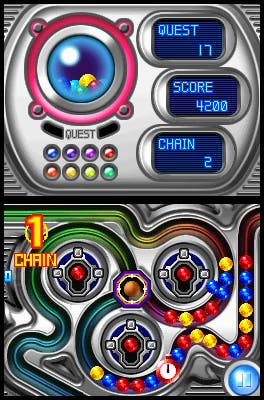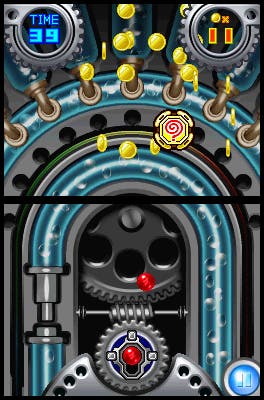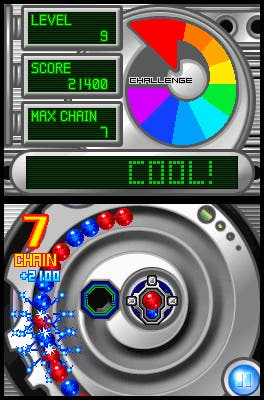Actionloop
Simple, but loveable.
If you keep up with the DS import scene, you might recall Nintendo releasing a puzzle game about nine months ago called Magnetica. Well, this is the same game under a different name - more in line with Mitchell's original PuzzLoop arcade game from 1998. Of course, if you've frequented the Xbox Live Arcade, you'll probably take one look at Actionloop and assume that this is a rip-off of PopCap's Zuma, but this is the real deal.
The gem-busting premise is largely the same as ever (i.e. heavily influenced by Bust-A-Move), but with a few interesting tweaks that, arguably, make the DS the best version of this hugely addictive puzzler. As ever, the idea is to make sure a spiralling line (or lines) of coloured gemstones doesn't reach the hole it's snaking toward. To do this, you have to continually flick gemstones from one or more launch pad(s) at the spiralling menace coming towards you - with three of a kind required to eliminate them.
The trick is to not only be quick and accurate, but to take advantage of The Rules of Attraction. If, for example, you match three reds and there are two yellow gems on either side, they will be attracted to one another, ensuring the line is dragged back a notch - helping to give you vital breathing space as you busily flick gems towards their target.
Zen puzzling

Actionloop manages to blend the formula three different ways, with varying degrees of success. By far the most maddeningly addictive is the Quest Mode, which contains 60 fiendish missions, along with a boss stage after every tenth level. The game is easily at its strongest when it's just tasking you with clearing all the gems, and this remains your sole goal on each and every stage. Where it starts to get more complicated is when it gives you multiple launch pads, not to mention multiple lines to clear. In what amounts to the puzzling equivalent of plate juggling, you're constantly having to divert your attention to what's going on elsewhere on the screen, trying desperately to stem the tide of one line, just as another threatens to reach its evil goal. When there are three... well, it starts to provide the kind of puzzling zen that all great games require to hold your attention.
But Actionloop doesn't simply provide more complicated layouts, it piles on the punishment in ever more fiendish ways. One minute you're trying to avoid little buzzing critters that deflect your gemstones away from your intended target, the next you're having to cope with electrified force-fields that shield entire sections of the line - forcing you to frantically focus on other sections to keep the line from encroaching too far.
And then just when you think it can't get any more evil, it starts placing black holes that suck your gems into oblivion if you stray too close to them, or it will fog up sections of the screen so that you can't even see the gems underneath. So what do you do? At first, I just tried a bit of educated guesswork, and then, knowing the DS I thought, "I bet you can blow them away". One quick puff later, the screen was clear. Genius. Your fellow commuters might question your sanity, however, so beware.
Points don't mean prizes
Now and then the game lends a helping hand, with various stopwatch icons appearing among the gems so that you can slow, stop or even reverse time if things are getting out of hand, or a Multicolour Bomb that lets you take out all the gems of the colour that you aim at. And if points are important to you, you can even direct gemstones into the little slots in the corner of the screen to activate a little fruit machine on the top screen - with bonus coins appearing if you get a matching pattern.

Anyone who played PuzzLoop or Zuma, though, will delight at just how well the game has been shaped around the DS. It's as if the game has finally found its true home, and works all the better as a consequence. Being able to use stylus strokes to flick gems with instant precision from the launch pad is a simply brilliant idea, and once you're having to constantly switch between multiple launch pads you soon realise the game just doesn't work as well using conventional control systems. Not only that, you get a much more satisfying sense of having full control over where the gemstones are going; with no need to rotate your aim, you can flick every which way in an instant, making games far more intense once things get going.
Checkmate mode, meanwhile, takes the opposite approach, and allows you to sit back and ponder your moves before you make them. Essentially, the idea still revolves around eliminating all the gems and not allowing them to reach the end of the line, but this time there's only a finite number on the screen, and they are fixed in position. For example, the early levels task you with clearing a small line of different coloured gems within three moves - with the general aim to cause a chain reaction in the right order so that one set explodes and triggers off the rest in the process. Sure enough, though, the challenge ramps up enormously - to the point where you're forced to try things every which way in order to root out a solution. Much like Mitchell's excellent (and rather under-rated) Polarium, you'll enjoy the challenge and admire the simple principle - and for quick sessions in a break at work or on a commute, Checkmate mode works like a charm, and with 60 modes to tackle, it'll last you weeks if you like chipping away at things at a leisurely pace.
Too much pressure
The mode that doesn't quite work as well, however, is the slightly ill-advised Challenge Mode. As John pointed out in his Magnetica review, it's just too frantic too soon, leaving you fighting for your life before you've had a chance to get into a groove. The general idea, again, is to eliminate gemstones just as with the Quest Mode. The difference here is that it's a level-based set-up, with the goal to get to level 99 to complete the challenge. Even on the basic Training level it's by no means a foregone conclusion, but on Normal (and beyond) it's utter chaos as soon as you get above level 50.

What tends to tip the balance into the realms of unfairness are the rockets that appear every tenth level - forcing the line of gemstones towards the end line unless you can destroy it by flicking a gem in its direction. At first, this isn't much of an issue (because you'll be able to keep up with the elimination process), but once the game starts increasing the number of different coloured gems on the screen, the harder it is to clear a path to destroy the rocket. It reduces an already pretty frantic task to a lottery, as you're mostly at the whim of the sequence in which the game spits out the gems. You might squeak through if there are clusters of two or more to take out, but it doesn't always work in your favour, leading to much hapless flicking and a resigned frustration that the game doesn't really want you to succeed anyway. You might enjoy this mode if you're feeling masochistic, but otherwise, the real fun is to be found elsewhere - I would argue with John's assertion that this is the 'main' mode - it's just the first of three single-player modes, and one that's easily ignored. The rest more than compensates.
So what of the multiplayer? Well, there's no CPU opponent, oddly (considering the second screen), but you can take advantage of frantic single pak or multipak wireless two-player fun. In this helplessly addictive mode, your main goal is to destroy your gems quicker than your opponent, while also making the best use of the attack items, such as Black Holes, Smoke, and gemstone blocking Pillars. In general, the rule is that the more gems you destroy, the more blockers appear on your opponent's screen, and the harder it becomes for them, so if you can find a player of equal ability it's a great deal of fun. If you fancy, you can also determine whether to use attack items at all, as well as a handicap if you want to even the odds with a newcomer. Another neat touch is the way the game does a data exchange with Polarium Advance (not DS, sadly), unlocking 10 additional stages and two 'special' tiles in the GBA title. Whether you'll care about the presence of Actionloop's rumble pack is dubious - it's probably not really worth trading off your battery life to be able to feel the gems 'clunk' into one another.
Although you might baulk at the prospect of paying £20 for an ageing puzzle game that you can play on other systems for a fraction of the price (in which case, mentally dock a mark or two depending on how much this influences your purchasing decision), there are more than enough unique tweaks and additions to make Actionloop a worthy addition to your DS puzzle collection. While it doesn't have the incessant allure of something like Zoo Keeper, it's yet another puzzle game that benefits greatly from the addition of touch-screen controls, and one that will definitely stay in our DS collection for a long time to come.









